Streamlining in the latter 1930s
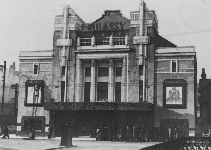 |
A transitional style is seen in the Embassy (1936) in Shawlands on
Glasgow’s South Side which retained the twin-towered look of the
earlier Commodore and Dundee Vogue, but carried the façade
detailing round the building’s side walls.
This commodious
1,638-seat cinema was built for the Harry Winocour Circuit – one
of Glasgow’s smaller cinema firms, but sold thereafter to Glasgow
Photo Playhouse, the owner of La Scala. |
Ironically, with the money he made from the Odeon deal, Singleton was
able to build many more super cinemas. This later batch included some
of McKissack’s finest designs and each attempted to incorporate
the bulk of its auditorium into a single, coherent architectural
statement.
Perhaps the effect of work by Mendelsohn in Germany and Frank Lloyd
Wright in the United States was at last being felt in Scotland. If so,
it most likely filtered through to architects such as McKissack via
projects by Thomas Tait, Basil Spence and the group of architects later
associated with Tait and the 1938 Empire Exhibition (Tait, of course,
was the assessor of the De La Warr Pavilion competition). Moreover,
McKissack would have been well aware of new developments in cinema
architecture elsewhere in Britain – such as Dreamland in Margate
(1934) by Leathart and Granger and the many fine cinemas designed by
assistants of Harry Weedon for Odeon. These were published in a glossy
and fulsomely-illustrated monthly magazine called
Cinema and Theatre
Construction, to which anybody involved in cinema design in the 1930s
would surely have subscribed.
Thus, Singleton’s
Vogue in Govan (1937) stood on a corner with a
curving cream frontage in fluted tiles carried to full height and
screening the mass of the auditorium, which was otherwise shielded from
view by surrounding tenements. The
Riddrie (1938) for Smith and Welsh
was located in the municipal suburb of that name and developed the
concept of differing volumes, arranged in proportion and building up to
the centrally-placed name sign.
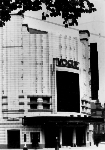
Vogue - Exterior |
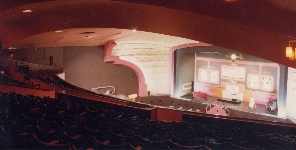
Vogue - Interior |
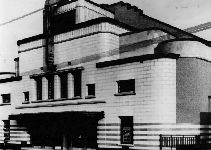
Riddrie - Exterior |
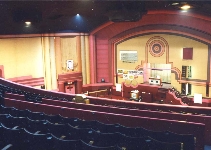
Riddrie - Interior |
These were large cinemas with 2,500 and
1,750 seats respectively. Within, they had compact front-of-house
spaces and spacious auditoria, the design of which emphasised the side
exit doors and the proscenium arches. At Govan, the entire front
section, ceiling, splay walls and curtain, was covered in silver paint
and illuminated by a continuous lighting trough, whilst Riddrie
featured closely-grouped columns with recessed decorative panels above
the side exit doors. Each interior made effective use of concealed
lighting.